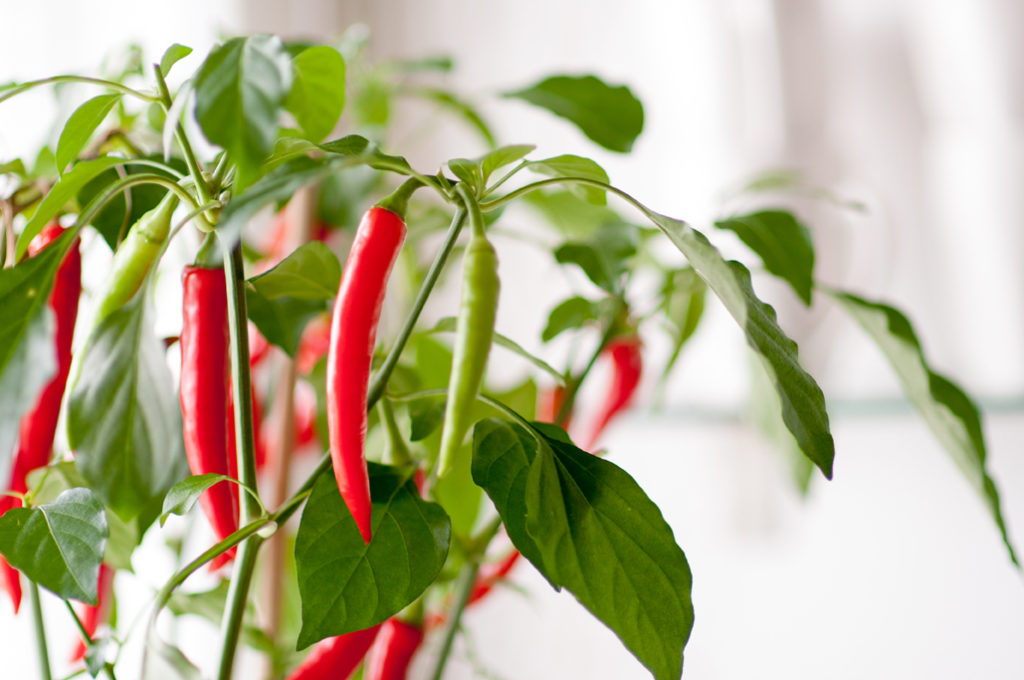Q. I enjoy Mexican food and other spicy foods, so I’ve been reading up about Chili Peppers. I’m now eager to plant a few, but there are so many varieties. Which varieties do the best in this area?
A. The popularity of Chili Peppers is increasing as more folks enjoy hot and spicy foods. Location, location, location is a key with Chili Peppers as they like warm days and nights to produce. They must have nighttime temperatures over fifty-five degrees. May is an ideal month to set out transplants or seedlings started in mid-March. In most years, the rainy season has concluded, and we are warming up. Seeds started today will be ready to the open ground in eight weeks, so I look to plant transplants. Chili peppers can be grown in containers as well as in the open ground. There are so many varieties because of the demand for hot and even hotter varieties. Hence, the right variety for you is directly related to how much heat your month is ready to accept. The chemical, which gives chili pepper its heat, is called capsaicin. They will also accumulate heat as it matures, so they’ll be milder when they’re green and hotter as they ripen to a deep red. The hottest part of the chili is the white flesh that attaches to the pepper’s seeds. This is removed if you want to limit the heat. William Scoville is credited with inventing the Scoville Heat Unit Scale (SHU), which measures Chili Peppers’ pungency. Bell or sweet peppers have a zero-rating. Here are a few of the hot peppers and their ratings: Jalapeno 10,000 SHU, Cayenne, 30.000 SHU, Habanero, 100,000 SHU. You may also find the Ghost Pepper, Bhut Jolokia, one of the hottest in the world at 1,000,000 plus SHU that’s four hundred times hotter than Tabasco Sauce. I’d recommend that you pick a couple of varieties to try out and then see for yourself if your yard adequate for more.
Note: Capsaicin is an irritant and key ingredient of Malice or pepper spray. It’s essential to either use gloves when handling chilies or thoroughly wash hands afterward. Anyone who has inadvertently rubbed his or her eyes after handling a pepper will know why.
Q. My neighbor has left me several twenty-four-inch pots. What can I plant in them that like lots of sun and are evergreen?
A. Today’s trend in container gardening is to plant many different types of plants such as ornamentals, grasses, succulents, herbs, and edibles in a single container. Typically, if it can be planted in the ground, it can also be planted in a container; hence, you have a wide and varied selection of choices. Citrus is by far the most popular individual plant in a pot. To start, I’d use sunset magazine or any other gardening publication as a source of inspiration. You’ll find many examples of mixed containers being used to enhance areas such as entryways, decks, and patios. You’ll need a tall focal point for a twenty-four-inch pot, a few medium-size plants, and then something low to use as filler. I’d use mounding or cascading plants as filler, so they spill over the sides to soften the sides of the pot. Here are a few suggestions for a focal point. Nandina, Heavenly Bamboo, has beautiful foliage color, gets berries in the fall, and is visibly light and airy. New Zealand Flax looks like a giant grass and is very sculptural. Dusty Miller has silver-gray foliage with yellow blooms in the summer. Any of the many types of grass-like Variegated Ribbon or Dwarf Fountain Grass can also be used. You could surround the focal point with the pink flowering Society Garlic or Lily of the Nile with blue flowers. They are available with both gray and green leaves. The yellow foliage of the Summer Gold Agapanthus is striking. Another option is the maroon leaf Corral Bells. Filler plants include Verbena Tapen, Million Bells, or Bacopa, which will flow over the containers’ sides. Seasonal color like Marigolds, Impatiens, Pansies, Iceland Poppies, Alyssum and Trailing or Upright Lobelia is added to complete the year-round color scheme. Do not forget that Parsley, Basil, and Rosemary make a dramatic impression in mixed containers. The containers can be identical. However, I’d prefer to mix the combinations up. I might reverse the foliage color between the focal point and the surrounding plants, using the filler plants to accent the groupings. Once you have an idea of what you want. I then visit your local garden centers a view of what’s available
A couple of final thoughts, the containers are kept fresh looking by changing the seasonal color. It takes very few plants or time to give them a new look. The biggest maintenance issue is water and nutrients. You have perfect drainage in a pot, so I’d water them daily when the temperatures are over seventy-five degrees. The containers should also be off the ground to allow the water to flow freely out the bottom. Some type of mesh or screening material is placed at the bottom, so the soil doesn’t wash out and feed every four months with Osmocote. It releases a little bit of nutrients every time your water.


Leave a Reply